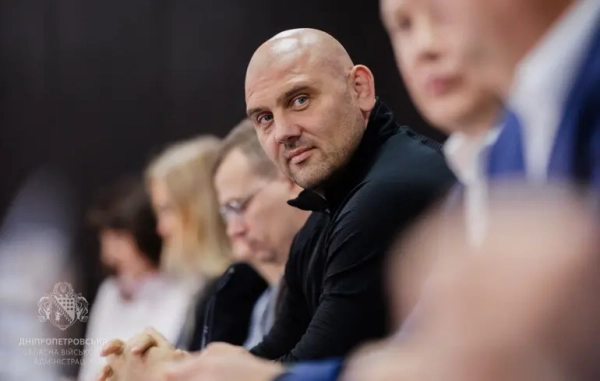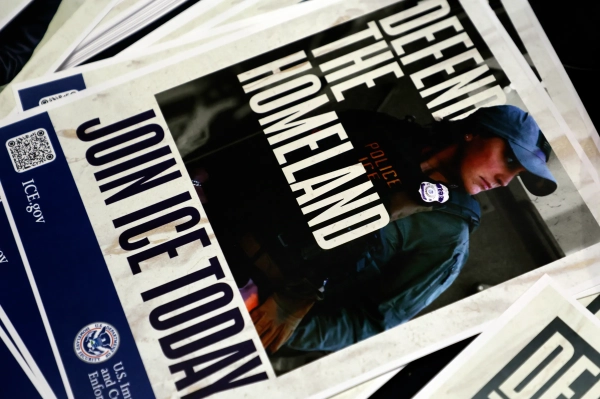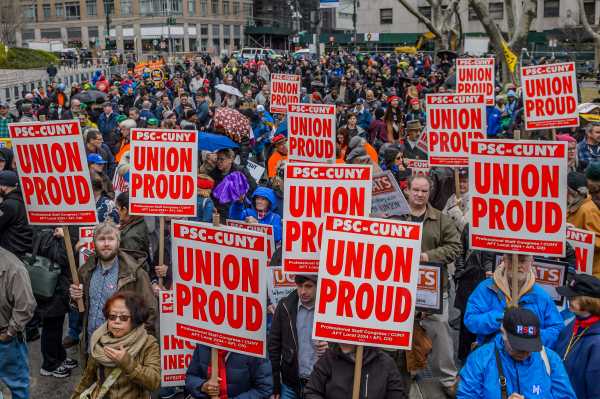
On Monday, the Supreme Court heard arguments in a case that public sector unions fear could deal a heavy blow by potentially reducing their financial coffers and opening the door for declines in membership.
The case, Janus v. AFSCME Council 31, hinges on a 40-year-old precedent allowing public sector unions to charge non-members who benefit from collective bargaining. The outcome could affect the operations of public unions, which represent state and government employees and function as one of the strongest parts of the union movement.
A similar case, Friedrichs v. California Teachers Association, went before the Court in 2016 but resulted in a 4-4 split decision following the death of Justice Antonin Scalia. But with a full court, including Trump appointee Neil Gorsuch, a conservative majority is expected to overturn the precedent upheld by Abood v. Detroit Board of Education in 1977, effectively turning the public sector into a “right to work” zone.
As with many cases that reach the Court, Janus has become a political proxy battle, with a number of conservative groups, like the Lynde and Harry Bradley Foundation, lining up in support of Janus while liberal organizations rally behind the unions. The case could also have an electoral impact, given the financial and personnel power unions often bring to political campaigns, with Democrats usually receiving the lion’s share of those benefits.
That outcome could also further weaken the power of public unions by creating new challenges in organizing strategy, political activity, and bargaining for workers.
Those pressures could be particularly significant for people of color, who have benefited greatly from membership in public sector unions. Union leadership and labor experts note that unions have played a historical role in the integration of the workforce and in providing opportunities to African Americans in the Jim Crow South. But they argue that unions continue to play a significant role in making wages and labor benefits more equal across racial and gender lines.
The Janus case, explained in 300 words
The case currently before the Supreme Court comes from Mark Janus, a child support specialist for the Illinois Department of Healthcare and Family Services. Janus is not a member of the American Federation of State, County, and Municipal Employees local chapter (the union working with many public sector workers in the state). But in Illinois and some 21 other states, workers are required to pay “fair-share” fees, even if they decline to join the union, because they still benefit from the union’s bargaining activities. Nonmember workers are not required to contribute to a union’s political lobbying activities or backing of political candidates.
Janus, however, argues that because public sector unions enter into bargaining agreements with the government, all of their activity should be seen as political. Specifically, Janus has been frustrated that the union has pushed for increased benefits at a time when Illinois is facing a budget crisis fueled by mismanagement of the state’s pension program. And because he disagrees with that political activity, he wants to be able to opt out of paying any fees to the union. Anything less, Janus and his lawyers argue, is an infringement on his First Amendment rights.
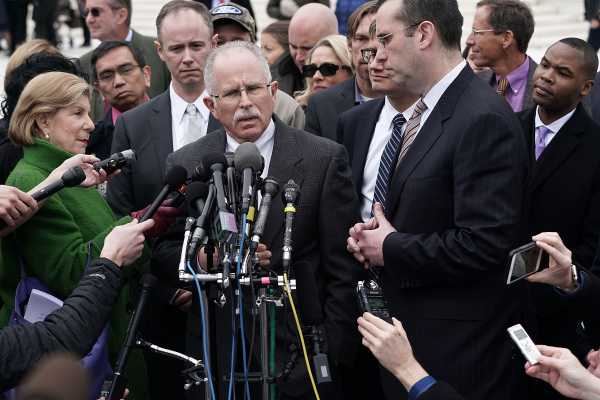

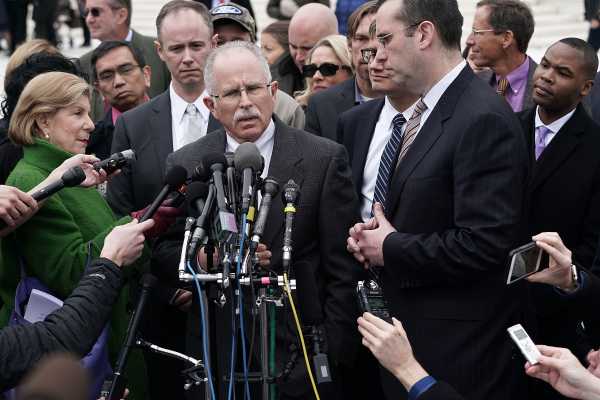
AFSCME and other public sector unions disagree. Instead, they see the case as a political attack on one of the last strongholds of the US union movement. According to NPR, citing data from the Bureau of Labor Statistics, “while the union membership rate in the private sector is a meager 6.5 percent, it’s more than a third among public employees.”
The court appeared to be divided as it heard arguments on Monday, with Justice Elena Kagan noting that the court has never reversed a case in which the reliance on precedent was so significant. Gorsuch, the expected deciding factor, remained silent for most of the arguments.
Unions say all workers would be affected by Janus. But the impacts could be greater for people of color.
Due to the current balance of the Supreme Court, Janus is expected to prevail, dealing a blow to public sector unions by enabling what economists call “free-riding,” opting out of paying dues while still receiving the benefits of the union’s bargaining efforts.
The exact effects of such a decision aren’t entirely clear. As FiveThirtyEight’s Amelia Thomson-DeVeaux notes, there’s no straightforward way of assessing the direct impact of free-riders on unions, although there is evidence that unionization is lower in the 28 states that currently have right to work laws. Thomson-DeVeaux adds that critics of the mandatory fees say that it is unlikely that unions will be wiped out since right to work states still have unions and increased member outreach could allow unions to retain a large number of paying members.
But unions argue that the fees that Janus and others like him are required to pay are necessary for union operations, and that workers, particularly the workers of color disproportionately represented in public sector unions, will be harmed if the court rules in his favor.
“A weaker union is going to be less able to protect its workers, and the people who basically need the most protection are those who are usually discriminated against,” Janelle Jones, an analyst for the Economic Policy Institute, tells Marketplace.
Unionizing particularly tends to benefit minority workers, especially women of color. Earlier this month, Jones and EPI labor counsel Celine McNicholas released a brief showing that black women could be especially harmed by the case, due to their high levels of participation in public-sector union jobs, including in the education system.
Black women and men in public sector unions also experience a smaller gap in pay when compared to the same groups in nonunion jobs, according to data from the EPI. The National Women’s Law Center notes similar findings, adding that Hispanic women also see pay and health care benefits better than their nonunion peers.
Historically, unions, which have not escaped charges of racism, have also served as a means of integrating the workforce. The first known right-to-work laws were created in an effort to push back against unions, some of which had incorporated ending segregation into their messaging. Proponents of the laws argued that union growth was synonymous with race-mixing and communism, in an effort to gain support.
The laws were opposed by civil rights leaders, including Martin Luther King Jr., who called right to work a “false slogan,” saying that “wherever these laws have been passed, wages are lower, job opportunities are fewer and there are no civil rights.”
King would go on to center economic justice and union rights in his Poor People’s Campaign, traveling to Memphis to support black sanitation workers fighting for union recognition. Currently, some 28 states have right to work laws on the books, and efforts to pass laws in more states have seen a resurgence in recent years, succeeding in places like Wisconsin.
Related
In 1968, Memphis sanitation workers went on strike. In 2018, their fight continues.
African Americans working in the public sector have already been affected by the Great Recession, which reduced the number of jobs available. If unions’ worst fears about the Janus decision turn out to be true, they could find a once reliable path to the middle class facing additional strain.
“Today, jobs in the public sector unions that are threatened by Janus provide the single greatest employment opportunity for African Americans,” Barrett Holmes Pitner explains at the Daily Beast. “Nearly 20 percent of African American adults work for the government in positions including teacher, child welfare services, mailman and everything in between. African Americans are 30 percent more likely than whites to have a public sector job.”
“If right to work is the law of the land in the public sector, it is going to have very negative impacts on people of color,” Lee Saunders, the current president of AFSCME and the first African American to serve in the role, tells Vox.
Pointing to the benefits unions have had for black women and families, he says that the case attacks “the very ability for people of color to have a decent life, to have decent wages and benefits,” adding that it will “take away the freedom to have a seat at the table and will continue to rig the system against” the working class.
On Saturday, thousands of workers across the country took part of the Working People’s Day of Action to show support for unions and workers’ rights, and to show how these issues connect to the broader struggles of marginalized groups and the working class.
In Chicago, one of the faces in the crowd was Stephen Mittons, a member of AFSCME’s Council 31 in Illinois who has worked as a child services investigator for more than 20 years. He says that unions have been valuable not only in helping workers secure benefits, but in enabling workers to better address community concerns.
“Public sector unions have been the main vehicle that has evened the playing field,” he says. “They’ve given people of color an opportunity to show their skills, to be able to compete.”
Sourse: vox.com
